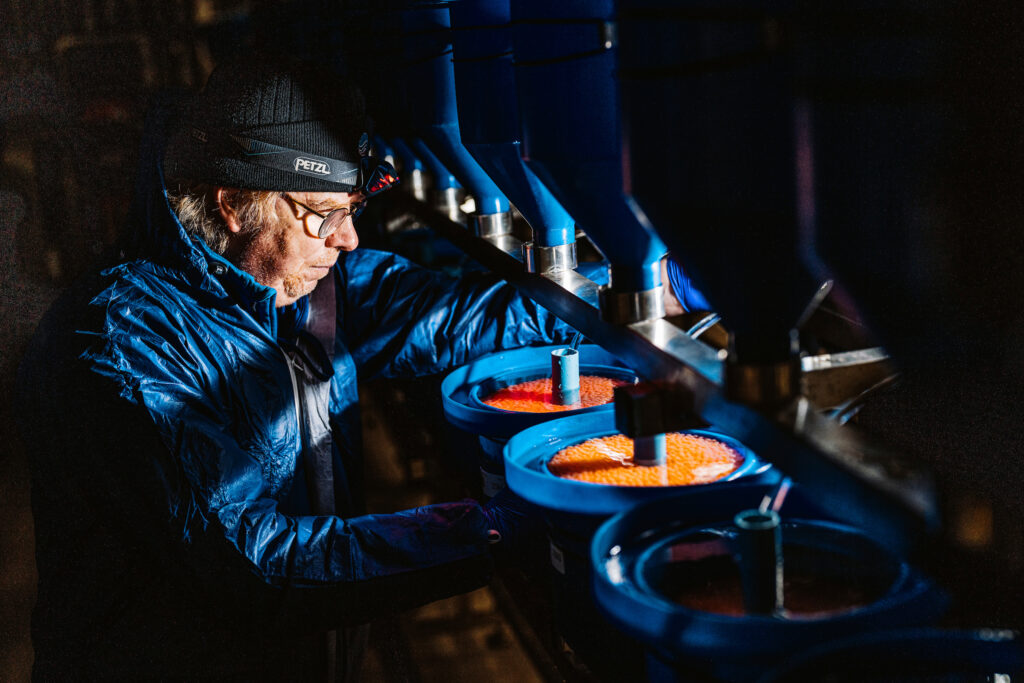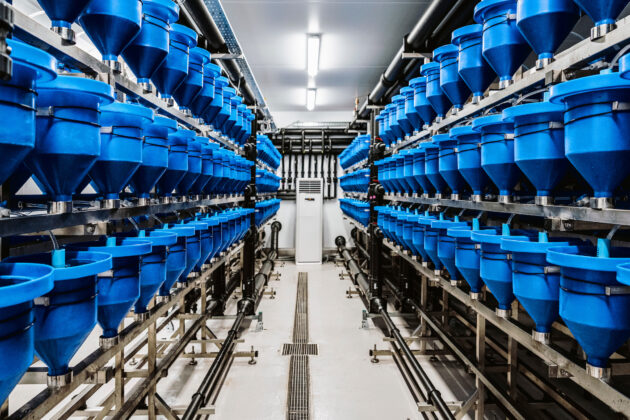
News & Views
Technology
Fish Health
Scottish Sea Farms incubation unit receives first set of eggs
March 27, 2024 By Hatchery International staff
 Egg inspection, incubation unit. (Photo: Scottish Sea Farms)
Egg inspection, incubation unit. (Photo: Scottish Sea Farms) Scottish Sea Farms has received the first batch of ‘green’ eggs at its new £2 million (US$2.5 million) incubation unit at the Barcaldine hatchery. The incubation unit is designed to receive eggs immediately after stripping, giving them greater control in the earliest days of the production cycle.
Rory Conn, head of freshwater, at Scottish Sea Farms, said the eggs, which were fertilized on-site, are doing well so far. Two smaller batches were trialled in Q4 2023 ahead of receiving its first full intake of around three million green eggs during Christmas. And these were fertilized on arrival at the new unit.
“We conducted a series of assessments, from evaluating the success of the fertilization process within the first 24 hours, to checking embryonic development around the 60-day stage. Then, when the eggs reach the eyed ova stage, they will go through a further quality check to ensure only the viable ones are transferred to incubation trays in our hatcheries,” said Conn. “From the results to date, we know already that the quality of water in the green egg unit has mitigated a number of the issues we had been seeing with our intakes of eyed ova.”
The eggs stay in the incubation unit, which is adjacent to the main Barcaldine Hatchery, for six weeks to five months before being moved to one of Scottish Sea Farms’ three hatcheries: Barcaldine, Knock on the Isle of Mull, or Girlsta in Shetland.

Scottish Sea Farms’ Zoug jars, incubation unit. (Photo: Scottish Sea Farms)
The new facility enables the eggs to be incubated for longer, at lower temperatures, during the most fragile stages of development. Conn said the temperature has been lowered to below 2°C which, research suggests, results in better outcomes for fish health later on, particularly cardiac health.
“From this initial batch alone, we will be able to put close to 600,000 smolts into one of our marine farms at the required time – around late August next year. Without the green egg unit, it simply wouldn’t have been possible to produce smolts from Scottish-sourced ova at this time of year.”
The unit uses the same water and recirculating aquaculture system technology as the company’s neighbouring Barcaldine Hatchery.
“This is a part of the production process that we haven’t been involved in until now and it is a reflection of the calibre of our people that they have got to grips with it quickly and are raring to go,” said operations manager Mike Tresise. “While pre-fertilised eggs will still be supplied to Barcaldine, a significant proportion of Scottish Sea Farms’ egg production will go through the green egg unit in the next egg season, which starts in Q3 2024.”
The unit has a total capacity of seven million ova at any one time and, with an input of up to three batches a year, it could potentially hold 20 million eggs annually. “The facility is delivering what we expected it to do with this first batch and I’m confident that we will be able to produce the number of eggs we need in order to meet our smolt requirements,” said Conn.
Print this page
Advertisement
- Viewpoint: I blame the Australian weather
- ‘Disappointing loss’: 160,000 trout lost in Oregon after novel parasite infection





